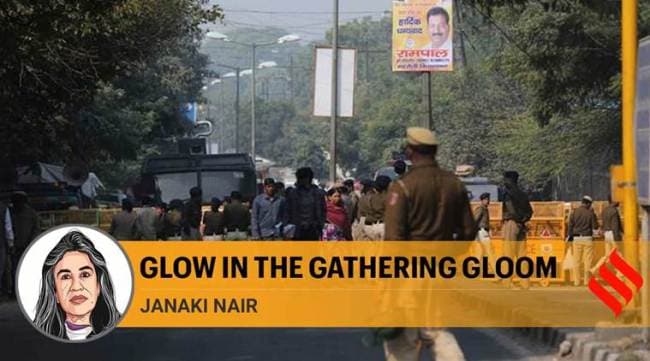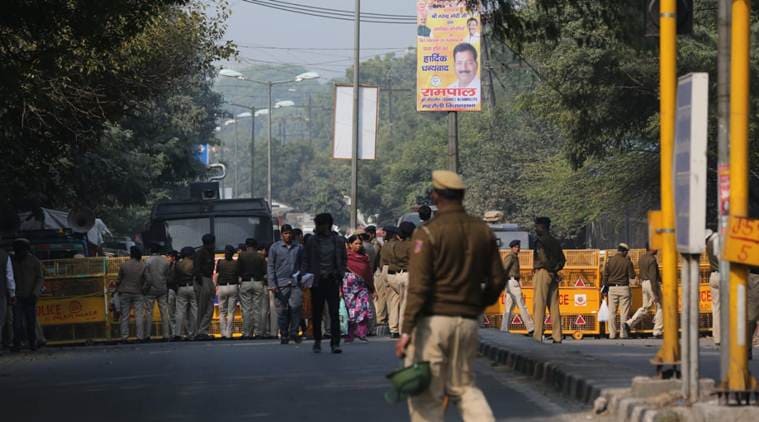Opinion JNU protests uphold public morality at a time when it’s being undermined
What the JNU students have upheld is a reminder of the importance of public morality, at a time when it has been degraded beyond recognition in our republic’s life.
 JNU protests uphold public morality at a time when it’s being undermined
JNU protests uphold public morality at a time when it’s being undermined  Police barricades during the JNU protests in New Delhi.
Police barricades during the JNU protests in New Delhi.
There is an awe-inspiring incandescence to the JNU students’ struggle which has lit up many institutions in India and elsewhere, and shows no sign of abating immediately. At a time of rapidly waning visionary futures, what does this fierce glow promise us? How is the steadfastness of this student body — consisting of many in their first semester — to be understood, especially their commitment to something larger and greater than themselves, of which they themselves may have only a tenuous grasp?
The Indian public university has been a politicised space from its very founding. It both produced and challenged the obvious inequities of colonial rule. In the early 20th century, it began to be recognised as a space for the redressal of caste inequalities — as in measures that were pioneered, for example, by the Mysore State in 1918. From the 1920s at least, it became an important site of nationalist and revolutionary agitation. Bengal in the late 1960s and the Sampoorna Kranti movements of Bihar in the 1970s took anti-government, anti-state student mobilisation to a new height. Despite the raging anti-reservation stirs of 1990 and 2006, the university, today, is the site of hard won state-mandated equality.
The student movements of the pre-Independence period were largely subordinated to the agendas of larger nationalist or communist parties, and were not necessarily engaged in intergenerational conflicts. Since Independence, there has been far greater engagement with university-related issues — hostels, fellowships, deprivation points, reservations, grading systems, fee hikes, and sometimes, though perhaps too rarely, course content.
The historic strike at the FTII in 2015 inaugurated a new phase of student movements — the students rose in defence of an idea of the institution and its unique place in Indian film history. FTII’s reputation was brazenly undermined by the appointment of Gajendra Singh Chauhan as chairman and four others to the institution’s council.
Many of its illustrious alumni also then believed that such appointments only undid the professional heights that this institution had reached. By January 2016, Hyderabad Central University exploded in anger over the tragic suicide of Rohith Vemula, and protests broke out throughout the country in support of another view of the public university, its achievements and also its injustices.
The JNU events of 2016 saw yet another shift of gear: While students were upholding their right to question the state, and its actions, much like the Sampoorna Kranti agitations of the 1970s, the institution was quickly daubed a different colour and dissent was declared unpatriotic. Since then, we have witnessed something like a war, between the idea of the university as a precious “gift of an interval”, to cite Michael Oakeshott’s memorable words, and the university as a cathedral, where unquestioning, militarised worship of the ethnicised nation has taken root.
At the same time, the JNU events beginning in February 2016 provided a fortuitous escape for a ruling party on the edge of a precipice: It temporarily masked the workings of an unruly market economy logic that had seized hold of higher education. That logic had already intervened and reconstructed institutions of higher learning to produce academic credentialling on an unmatched scale — the capitation fee phenomenon, for example. That was the more benign form; the pernicious form reached its epitome in the industrial-scale cheating that was pioneered in Madhya Pradesh, where the BJP held office, and goes by the name of the Vyapam scam.
Of late, there have been anti fee-hike agitations in institutions ranging from IIT Mumbai in 2017 to the Uttarakhand Ayurvedic University in October 2019. That they have not attained the high visibility of the JNU agitation is not so much because they were any less heroic, but because JNU enjoys hyper-visibility for simultaneously being the site of excellence — at least for the last 45 years — and exemplary inclusion. The frontal attack on both of these cherished values will make way not just for a market logic to triumph in what may be a last bastion, but to reassert privileges — of caste, ethnicity and gender — that had been painstakingly dismantled. The EWS quota has already paved the way.
Is the determined student struggle at JNU looking back with nostalgia at a public university that was, or heralding the public university’s new future? When the prospects of steady, well paid, or dignified work are so bleak, and when even those with academic credentials no longer harvest the same “returns” that might have been true even a decade ago, what can motivate the students to take such an unwearied stand?
To make any hackneyed point about the dreams and revolutionary ardour of youth would be to dishonour the movement. What the JNU students have upheld is a reminder of the importance of public morality, at a time when it has been degraded beyond recognition in our republic’s life. That is the precious glow we perceive in this gathering gloom.
This article first appeared in the print edition on December 11, 2019 under the title ‘Glow in the gathering gloom’.. The writer teaches history at JNU.





